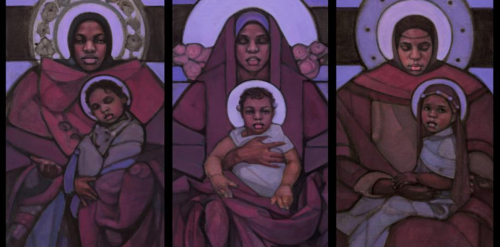
| Giving Birth to Christ Tuesday, December 8, 2020 Why, from the earliest centuries, have Christian people been so excited about Mary? What’s happening in the depths of our soul when we hear her story? Surely it must be about more than the miracle of the virgin birth. As Benedictine oblate, author, and poet Kathleen Norris shares, Mary’s “virginity” has less to do with biology than with her stance towards God and life itself.It’s in the monastic world that I find a broader and also more relevant grasp of what it could mean to be virgin. Thomas Merton, in Conjectures of a Guilty Bystander, describes the true identity that he seeks in contemplative prayer as a “point vierge” [virgin point] at the center of his being, “a point untouched [by sin and] by illusion, a point of pure truth . . . which belongs entirely to God. . . .” [1]It is only when we stop idolizing the illusion of our control over the events of life and recognize our poverty that we become virgin in the sense that Merton means. . . . We all need to be told that God loves us, and the mystery of the Annunciation reveals an aspect of that love. But it also suggests that our response to this love is critical. A few verses before the angel appears to Mary in the first chapter of Luke’s Gospel, another annunciation occurs; an angel announces to an old man, Zechariah, that his equally aged wife is to bear a son who will “make ready a people prepared for the Lord.” The couple are to name him John; he is known to us as John the Baptist [Luke 1:11–18]. Zechariah says to the angel, “How will I know that this is so?” which is a radically different response from the one Mary makes. She says, “How can this be?”I interpret this to mean that while Zechariah is seeking knowledge and information, Mary contents herself with wisdom. . . . Mary’s “How can this be?” is a simpler response than Zechariah’s, and also more profound. She does not lose her voice but finds it. Like any of the prophets, she asserts herself before God, saying, “Here am I.” . . . Mary proceeds—as we must do in life—making her commitment without knowing much about what it will entail or where it will lead. I treasure the story because it forces me to ask: When the mystery of God’s love breaks through into my consciousness, do I run from it? . . . Or am I virgin enough to respond from my deepest, truest self, and say something new, a “yes” that will change me forever? [2]If Jesus is the representative of the total givenness of God to creation, then perhaps Mary is the representative of humanity, showing us how the gift is received. And I believe that is why we love Mary. She’s a stand in for all of us. When we can say, like her, “Let it be,” then we’re truly ready for Christmas. After further reflection, the Daily Meditations editorial team has decided to substitute a new image for this week’s theme. In our original choice, Mary appears white and is in the center of the image, while the two women adjacent to her are black. We recognize the historic centering of whiteness in Western art and religion, and we strive to use images in the Daily Meditations that disrupt this legacy. Together, we are developing, growing, and changing for the good—towards an ever more inclusive love in Christ. (The Universal Christ, 95) Gateway to Action & Contemplation: Story from Our Community: I am a United Methodist pastor and . . . when the pandemic started . . . I started sharing the [Daily Meditations] online in our private Facebook group Monday – Friday. I could not have imagined how life-giving sharing these meditations would be. In a year of so much loss, these daily readings have helped us find comfort, given us strength to make hard decisions, and bound us together in a web of love. Thank you for sharing your wisdom and love with so many. It has made this year bearable. Thank you. —Jen S. |
